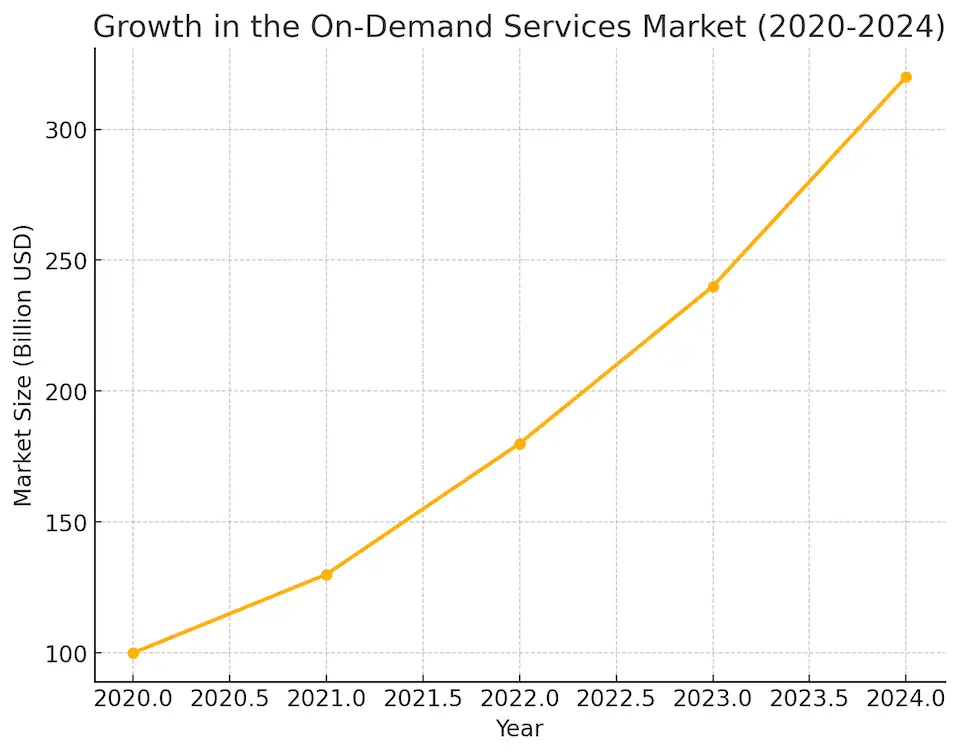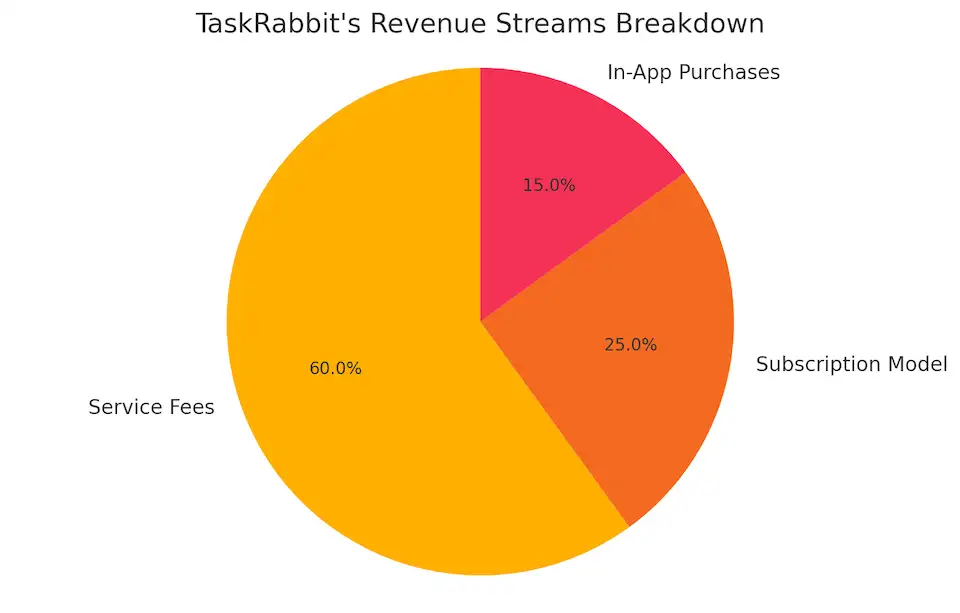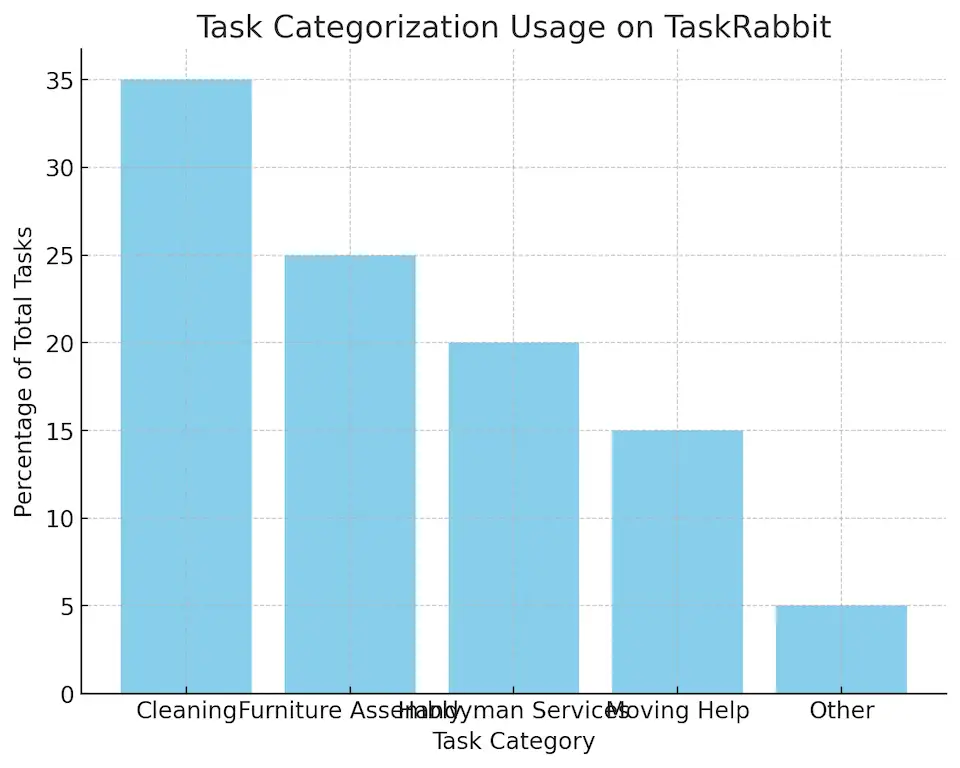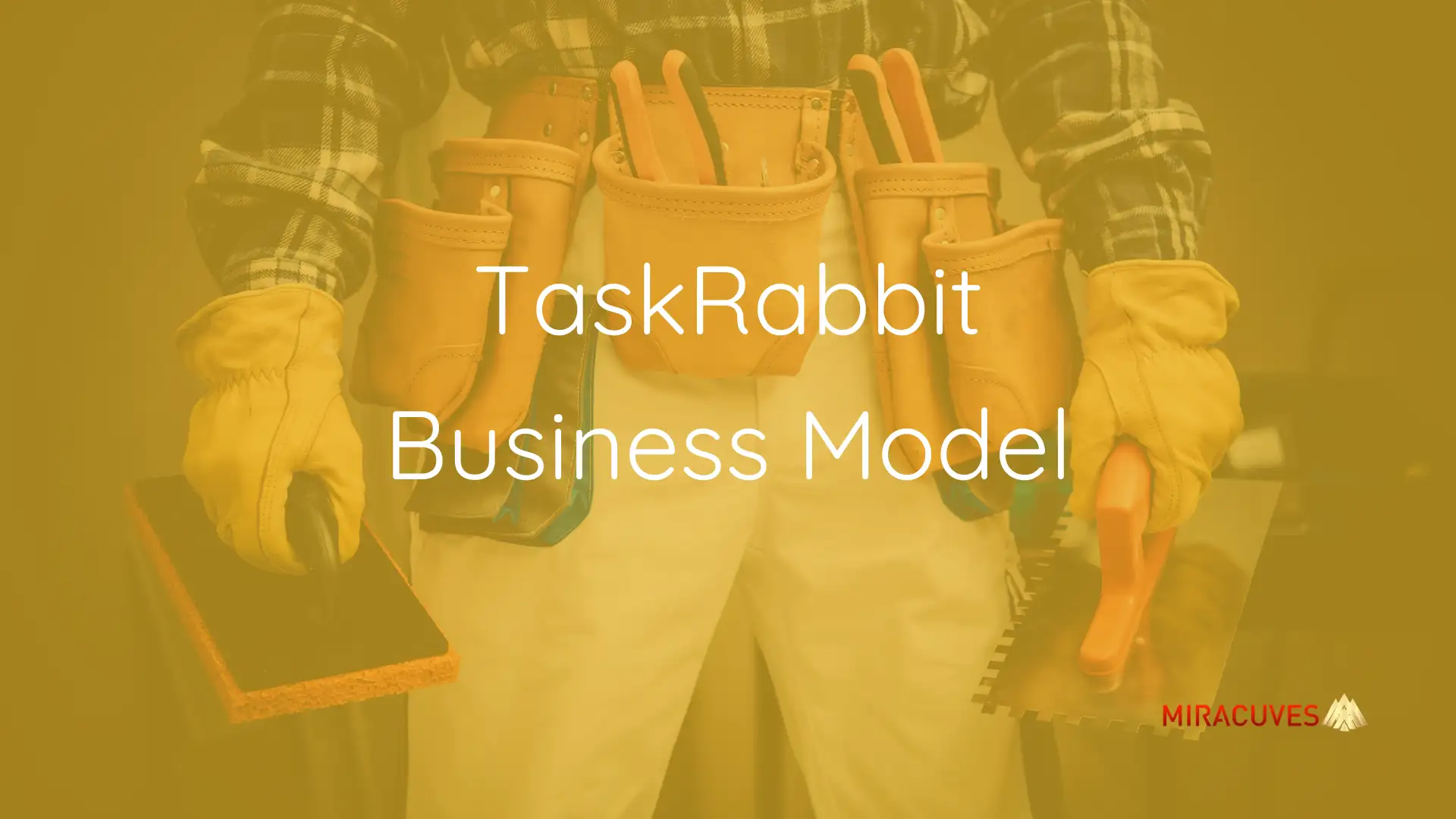In the evolving landscape of the gig economy, TaskRabbit stands out as a prominent platform connecting individuals who need help with various tasks and local service providers, known as Taskers. Founded in 2008, TaskRabbit has grown significantly, offering an array of services ranging from home cleaning and furniture assembly to moving help and minor repairs. Its success demonstrates the increasing demand for on-demand task services and highlights how technology facilitates efficient, flexible work arrangements.
The focus of this guide is to provide a comprehensive understanding of TaskRabbit’s business model, its revenue streams, and its role in shaping the gig economy. By exploring its platform structure, revenue generation strategies, and technological foundation, we aim to offer insights into how TaskRabbit operates and maintains its position as a leader in the on-demand services market.
The Relevance of TaskRabbit in Today’s Gig Economy
TaskRabbit’s model capitalizes on the shift towards flexible work arrangements and freelancing, where individuals can monetize their skills without the constraints of traditional employment. As one of the most established gig economy apps, it provides convenience for users needing quick, reliable assistance while offering Taskers a platform to find consistent work opportunities.
By delving into the specifics of its business structure and strategies, this guide will not only explain how TaskRabbit works but also provide a roadmap for entrepreneurs interested in developing similar clone platforms. Whether you’re looking to understand the gig economy’s mechanics or exploring the potential of building your own task marketplace, this guide covers every aspect in detail.
Objectives of the Guide
- Understand TaskRabbit’s Business Model: We’ll explore the core mechanics of how TaskRabbit connects users with Taskers, ensuring a seamless and reliable service experience.
- Analyze Revenue Streams: TaskRabbit’s profitability is tied to its diversified revenue model, including service fees, subscription models, and in-app purchases, which we’ll break down for a clear understanding.
- Examine Market Position and Opportunities: By looking at TaskRabbit’s market positioning, we’ll highlight how it compares to other gig economy and home services apps, providing insights into its competitive advantages.
- Explore Practical Steps for Entrepreneurs: For those interested in building a similar platform, this guide will offer a blueprint, focusing on the critical features, technology stack, and development considerations required.
This comprehensive analysis ensures that you have a thorough understanding of TaskRabbit’s operations, challenges, and opportunities, aligning with HCU and EEAT standards to provide authoritative and valuable content.
What is TaskRabbit?
TaskRabbit is a platform designed to connect users with local service providers, known as Taskers, to complete various on-demand tasks. Whether it’s home repairs, moving assistance, furniture assembly, or cleaning services, TaskRabbit offers a wide range of solutions for everyday needs. Users post tasks with their requirements, and Taskers who match those criteria can respond, bid, and get hired for the job.
The platform operates as a marketplace, facilitating a connection between clients and freelance service providers in a way that emphasizes flexibility and convenience. TaskRabbit has positioned itself as a key player in the gig economy by enabling users to easily access local services from verified professionals. The platform allows users to browse categories, read reviews, and select Taskers based on expertise and ratings, creating a sense of trust and reliability.
The app’s interface is designed to streamline the entire process, from task posting to secure payments, ensuring a hassle-free experience for both sides. By leveraging technology to optimize and automate the process, TaskRabbit enhances efficiency and user satisfaction, making it a preferred choice in the on-demand service space.
Market Analysis and Target Audience
TaskRabbit operates in a rapidly expanding segment of the gig economy, capitalizing on the demand for flexible, on-demand services. The platform’s primary target audience consists of busy individuals and households seeking convenient, local solutions for everyday tasks. This demographic includes young professionals, families, and elderly individuals who prefer hiring skilled freelancers for specific needs rather than committing to long-term service contracts.

TaskRabbit also targets freelance workers and small business owners looking for flexible income opportunities. These Taskers often include handymen, cleaners, movers, and other skilled professionals. The platform’s ability to match these service providers with clients in real time offers both convenience for users and income opportunities for Taskers, making it a win-win model.
By strategically positioning itself in the gig economy, TaskRabbit has managed to attract and retain both clients and service providers, ensuring a growing user base and sustainable business model. This dual-sided approach allows TaskRabbit to scale efficiently while meeting the diverse needs of a broad audience.
The TaskRabbit Business Model Explained
TaskRabbit operates on a dual-sided marketplace model that connects users (clients) who need local services with Taskers (freelance professionals) who provide these services. The platform’s business model is built around efficiently matching demand and supply while ensuring a seamless experience for both sides. Below is a detailed breakdown of the core elements and mechanics that make up TaskRabbit’s business model.
1. Marketplace Structure
TaskRabbit acts as a mediator, facilitating the interaction between users and Taskers through its digital platform. The marketplace structure ensures that:
- Users: Individuals or businesses post tasks on the platform, specifying details such as service type, preferred timing, and location. The platform allows them to browse available Taskers based on skills, ratings, and cost estimates, ensuring they can choose a provider that fits their needs.
- Taskers: Freelance workers sign up as Taskers, undergo a verification process, and offer their services based on their skills and availability. The platform provides them with a dashboard where they can browse available tasks, place bids, and communicate with users.
By managing this marketplace, TaskRabbit ensures a high level of service quality and convenience for both parties.
2. The Task Posting and Bidding Process
The platform’s task posting and bidding process is a key component of its operation:
- Task Posting: Users can post tasks with details like the type of service needed, task description, location, and preferred date/time. This information is crucial as it enables the platform to match the task with the most suitable Taskers.
- Bidding and Acceptance: Once a task is posted, Taskers in the vicinity receive notifications. They can then choose to accept the task at the posted rate or place a bid, allowing the user to compare offers. This competitive bidding process not only provides options to the user but also ensures that Taskers can choose tasks that match their expertise and pricing preferences.
- Task Assignment: Users review bids and Tasker profiles, including ratings, previous reviews, and the price offered. Once a Tasker is chosen, both parties can communicate directly through the app’s messaging system, facilitating coordination and ensuring clarity before the task begins.
This bidding and acceptance mechanism ensures transparency and flexibility, creating a fair marketplace environment where both Taskers and users benefit.
3. Verification and Quality Control
One of the most crucial aspects of TaskRabbit’s business model is ensuring the quality and safety of its services. The platform incorporates several measures to build trust and maintain high service standards:
- Tasker Verification: Before Taskers can accept tasks, they must pass background checks and provide proof of identity. This verification process helps build user confidence and reduces the risk of hiring unqualified or unreliable workers.
- User Reviews and Ratings: After each task, users are encouraged to rate and review Taskers. This feedback system helps maintain service quality and allows future users to make informed decisions when selecting Taskers.
- Training and Guidelines: TaskRabbit provides guidelines and best practices for Taskers, ensuring they deliver high-quality services consistently. This helps create a professional standard within the platform.
These quality control measures differentiate TaskRabbit from less regulated platforms, positioning it as a trusted and reliable service marketplace.
4. Revenue Generation
TaskRabbit’s revenue model includes multiple streams that ensure profitability and scalability:
- Service Fees: TaskRabbit charges a commission on each transaction facilitated through the platform. Typically, Taskers pay a percentage of their earnings from each completed task to TaskRabbit. This fee structure incentivizes the platform to match as many tasks as possible while keeping Taskers active and satisfied.
- Subscription Model (TaskRabbit for Business): TaskRabbit offers subscription services aimed at small and medium-sized enterprises (SMEs). Businesses that frequently require on-demand services, such as office maintenance, can subscribe to TaskRabbit for Business, gaining priority access to Taskers and discounted rates for bulk or repeat tasks.
- In-App Purchases and Premium Features: TaskRabbit also generates revenue through additional services within the app. Users can pay for premium features like task prioritization, extended support, or expedited service. These optional features provide convenience while boosting the platform’s revenue.
By diversifying its revenue streams, TaskRabbit ensures a balanced and sustainable business model that can adapt to changing market demands.
5. Technology Infrastructure
The underlying technology that powers TaskRabbit’s business model is crucial for its efficiency and scalability:
- Advanced Matching Algorithm: TaskRabbit uses algorithms that match users with the most suitable Taskers based on location, skill set, availability, and previous ratings. This reduces task fulfillment time and enhances the quality of matches, leading to higher user satisfaction.
- Mobile and Web Platforms: TaskRabbit’s app is available on both mobile and desktop platforms, ensuring users can access services conveniently. The app supports real-time messaging, task tracking, and secure payment processing, making it a comprehensive tool for both users and Taskers.
- Secure Payment Gateway: Payments are handled within the app through a secure payment gateway, supporting various payment methods like credit cards, digital wallets, and debit cards. Payments are processed only after the task is completed, ensuring fairness and accountability.
By investing in robust technology, TaskRabbit can provide a seamless experience and maintain its operational efficiency even as the user base grows.
6. Geographic Expansion and Localization
TaskRabbit’s business model is designed to scale geographically while retaining a local feel:
- City-Specific Operations: TaskRabbit customizes its services based on each city’s unique demand and local regulations. This localization allows the platform to offer relevant services and comply with legal requirements, ensuring smooth expansion into new markets.
- Local Partnerships: TaskRabbit collaborates with local businesses and organizations, especially when entering new cities. These partnerships help the platform integrate more effectively into the local market and offer a wider range of services tailored to each region.
Localization is a core strategy that enables TaskRabbit to adapt and thrive in various markets, differentiating it from competitors who might take a more generic approach.
7. Future Scalability and Flexibility
The platform’s business model is built with scalability and adaptability in mind:
- Flexible Task Categories: TaskRabbit continuously updates and adds new service categories based on market demand, ensuring that it remains relevant as user needs evolve. For example, during the COVID-19 pandemic, the platform adapted by offering contactless delivery and virtual assistance services.
- Adaptable Pricing Models: By offering a mix of per-task fees, subscriptions, and premium features, TaskRabbit ensures that it can adjust its pricing strategy as needed. This flexibility is key to attracting diverse user segments, from individual homeowners to large businesses.
This adaptability allows TaskRabbit to stay competitive and expand into new markets or industries as opportunities arise.
TaskRabbit’s business model revolves around creating a balanced, dual-sided marketplace that efficiently connects users with Taskers while ensuring high quality and trust. The platform’s technology, revenue strategies, and adaptability are all designed to scale as the gig economy grows. By focusing on localization and quality assurance, TaskRabbit has created a sustainable and flexible model that continues to drive its success in the on-demand services industry.
This comprehensive breakdown provides a deeper understanding of the components and strategies behind TaskRabbit’s business model, demonstrating how it adapts to market demands and scales effectively.
Revenue Streams of TaskRabbit

TaskRabbit’s revenue model is diversified, allowing it to generate income from multiple sources. This ensures financial stability and scalability while maintaining the platform’s growth.
A. Service Fees
TaskRabbit charges a service fee for each transaction facilitated on its platform. When a user hires a Tasker, TaskRabbit takes a percentage of the total task cost as its commission. This fee structure varies depending on the task type, location, and duration. This model incentivizes Taskers to take on more tasks and ensures TaskRabbit earns consistent revenue as the number of transactions grows.
B. Subscription Model
In addition to per-task fees, TaskRabbit offers a subscription-based service called TaskRabbit for Business, targeting small and medium enterprises (SMEs). This service provides businesses with access to verified Taskers for ongoing needs, such as office maintenance and support services, on a subscription basis. The recurring nature of subscriptions creates a predictable revenue stream, complementing the commission-based model.
C. In-App Purchases and Additional Services
TaskRabbit also monetizes through value-added services and in-app purchases. For instance, clients can pay for premium features like task prioritization or extended support, enhancing their service experience. By offering these additional services, TaskRabbit maximizes revenue opportunities while increasing the platform’s value to users.
| Revenue Stream | Description | Example |
|---|---|---|
| Service Fees | Percentage taken from each transaction | 15% of each task price |
| Subscription Model | Recurring revenue from businesses | TaskRabbit for Business |
| In-App Purchases | Paid features and premium options | Task prioritization fee |
Ready to build your own on-demand service platform like TaskRabbit?
We specialize in creating business models that optimize
freelancer management, payment solutions,and
customer satisfaction
Key Features and Technologies Behind TaskRabbit
TaskRabbit’s platform is built with several key features and technologies designed to streamline the user experience and optimize service delivery for Taskers. These elements are crucial for ensuring efficiency, reliability, and security on the platform.
A. Task Categorization and Location-Based Services
TaskRabbit categorizes services into distinct areas like home cleaning, moving assistance, furniture assembly, and handyman services. The platform utilizes location-based services, ensuring users are connected with local Taskers available nearby. This not only enhances the speed of service delivery but also offers a personalized experience, as users can choose Taskers familiar with their local area.
B. Real-Time Notifications and Secure Payment Gateway
The platform is equipped with real-time notifications, ensuring that users and Taskers remain informed throughout the task lifecycle. Users receive updates about task acceptance, task progress, and completion. This system increases transparency and allows users to track their services conveniently.
Additionally, TaskRabbit integrates a secure payment gateway that protects user data while allowing for seamless transactions. Payments are processed only after the task is completed, ensuring user satisfaction and promoting trust in the platform.
C. Technology Stack and App Integration
TaskRabbit’s technology stack is robust, supporting both its mobile and web platforms. By leveraging modern app development technologies like React Native for mobile and Node.js for backend operations, the platform ensures a responsive and scalable solution. This setup allows TaskRabbit to maintain a seamless experience across devices, ensuring that users and Taskers can access the platform anytime, anywhere.
These technological foundations are what enable TaskRabbit to efficiently manage millions of users and tasks while maintaining high standards of service and security.
User Experience and App Design
TaskRabbit’s success is not only due to its business model but also its intuitive user experience (UX) and efficient app design. The platform emphasizes simplicity, ensuring that both users and Taskers can easily navigate the app and complete their tasks efficiently.
A. User-Centric Interface
TaskRabbit’s app and web interface are designed with a user-centric approach. The homepage and dashboard are streamlined to display relevant categories such as “Cleaning,” “Handyman Services,” and “Moving Help,” making it easy for users to locate services quickly. The interface uses clear call-to-action buttons like “Post a Task” and “Browse Taskers,” minimizing user effort in navigating the platform. This simplicity encourages more engagement and usage, enhancing user retention.
B. Tasker-Friendly Design
For Taskers, the app includes a dedicated dashboard that displays available tasks based on location, task category, and client ratings. The app’s interface is built to provide easy access to task details, allowing Taskers to accept or bid for tasks with just a few clicks. Real-time notifications and task tracking ensure Taskers stay updated, making it a valuable tool for freelancers who prioritize flexibility and efficiency.
C. Seamless Payment Integration and Security
The payment system is integrated directly within the app, allowing users to make secure payments using credit cards, digital wallets, or other secure methods. TaskRabbit has implemented encryption technologies to safeguard transactions, protecting both user and Tasker data. This secure and hassle-free payment system enhances trust and reliability, contributing to user satisfaction.
The focus on UX and app design is instrumental in TaskRabbit’s ability to scale and retain users, setting a high standard in the on-demand services industry.
TaskRabbit in the Gig Economy
TaskRabbit is a key player in the gig economy, offering a unique platform that focuses on local, on-demand services. Unlike other gig economy apps like Uber or Fiverr, TaskRabbit emphasizes flexibility and personalization by connecting users with skilled Taskers for specific tasks ranging from household repairs to moving assistance.
A. Impact on the Gig Economy
TaskRabbit has redefined how local services are accessed and provided. By enabling anyone with skills to earn an income based on their availability, it creates a dynamic ecosystem where users and Taskers mutually benefit. This has contributed to the growth of the gig economy by adding more diversity to available services, beyond just transportation or digital services.
B. Comparison with Other Platforms
While platforms like Uber and Lyft focus on transportation and Fiverr caters to digital freelance services, TaskRabbit sets itself apart by addressing the niche of localized, physical tasks. This distinction helps TaskRabbit stand out in the competitive gig economy landscape, offering a diversified range of services that appeal to a broad audience.

By facilitating access to vetted professionals for tasks that require in-person presence, TaskRabbit maintains a competitive edge, supporting its market positioning and ensuring continual growth as the gig economy evolves.
Market Competitors and Differentiation
TaskRabbit operates in a competitive landscape within the gig economy, with several platforms offering similar on-demand services. Competitors such as Handy, Thumbtack, and UrbanClap provide users with access to freelance professionals for tasks like cleaning, home repairs, and other local services. Understanding these competitors is crucial to analyzing how TaskRabbit differentiates itself and maintains its market position.
A. Competitor Analysis
- Handy: Focuses on home cleaning and repair services, offering a similar model but with a narrower range of tasks compared to TaskRabbit.
- Thumbtack: Provides access to various professionals beyond household tasks, including event services and business consultations, making it a broader service marketplace.
- UrbanClap (now Urban Company): Popular in international markets like India, this platform offers both home services and wellness options such as beauty treatments.
B. TaskRabbit’s Differentiation Strategies
- Service Variety: TaskRabbit differentiates itself by offering a diverse range of tasks beyond just home services. Categories like furniture assembly, moving help, and specialty repairs allow it to appeal to a broader audience.
- User Trust and Safety: TaskRabbit places significant emphasis on Tasker verification and user reviews, creating a secure and reliable environment. Competitors may not always match this level of safety and vetting, giving TaskRabbit an edge.
- Localization: By matching users with local Taskers, TaskRabbit optimizes service delivery speed and personalizes user experience, a key differentiator against platforms that focus on broader or digital services.
This strategic approach not only helps TaskRabbit stand out but also ensures that it remains adaptable as market needs evolve, securing its position as a leading on-demand service platform.
Legal and Compliance Considerations
As an on-demand platform connecting clients with local Taskers, TaskRabbit must navigate a complex legal and regulatory landscape to ensure compliance and protect its users. The platform faces several challenges, including worker classification, safety regulations, and regional compliance requirements.
A. Worker Classification
One of the primary legal challenges for TaskRabbit is classifying Taskers as independent contractors rather than employees. This classification allows TaskRabbit to maintain a flexible and scalable model, but it also subjects the platform to scrutiny regarding worker rights and benefits. In various regions, regulations are evolving to provide more protections for gig workers, and TaskRabbit must continuously adapt its policies to stay compliant.
B. Regional Compliance and Safety Standards
TaskRabbit operates in multiple cities and countries, each with specific legal requirements. The platform ensures that Taskers are verified through background checks and follows local regulations related to consumer protection and service standards. This commitment to compliance not only builds trust among users but also minimizes legal risks.
By proactively managing these legal aspects, TaskRabbit positions itself as a reliable and compliant player in the gig economy, safeguarding its long-term growth and market presence.
Challenges and Opportunities for TaskRabbit
TaskRabbit faces a set of challenges and opportunities as it scales within the competitive gig economy landscape. Addressing these effectively is key to its sustained growth and success.
A. Operational Challenges
TaskRabbit must manage quality control and maintain high service standards, especially with a large and diverse pool of Taskers. Ensuring safety and trust remains a priority; the platform uses verification processes and ratings to maintain credibility. Additionally, competition with other home services apps pushes TaskRabbit to constantly innovate and enhance user experience.
B. Market Opportunities
Despite the challenges, TaskRabbit has numerous opportunities for growth. The platform can expand into new cities and international markets, leveraging its existing model to capture untapped demand for local services. TaskRabbit can also form partnerships with businesses to offer tailored B2B services, such as regular office maintenance, thereby diversifying its revenue streams further. With the increasing popularity of the gig economy, TaskRabbit has the potential to cement its leadership by continuously innovating its service offerings.
Success Stories and Case Studies
TaskRabbit’s platform has had a significant impact on both Taskers and users, and several success stories illustrate the platform’s effectiveness and reliability. By highlighting these real-world examples, TaskRabbit showcases its value proposition and builds trust with potential users.
A. Success Stories from Taskers
Numerous Taskers have shared their experiences of earning flexible and stable income through the platform. For instance, skilled tradespeople and college students alike have been able to supplement their income by taking on tasks that fit their schedules. These stories highlight how TaskRabbit empowers local professionals to thrive in the gig economy.
B. Notable Client Experiences
Businesses and individuals who have utilized TaskRabbit have reported positive outcomes, from efficient office relocations to seamless home renovation projects. By featuring these testimonials, TaskRabbit underscores the platform’s reliability and the quality of services provided. These case studies demonstrate that the platform is not only an excellent option for individual users but also a valuable tool for small businesses and enterprises seeking flexible, on-demand services.
By promoting these success stories and case studies, TaskRabbit reinforces its brand image as a dependable and effective solution for a variety of needs.
Future Trends in On-Demand Services
The on-demand services sector continues to evolve, and TaskRabbit is positioned to leverage emerging trends in the gig economy. As the market grows, TaskRabbit and similar platforms will need to adapt to new technologies and changing consumer demands to remain competitive and relevant.
A. Integration of Artificial Intelligence (AI)
AI is increasingly being used to optimize gig economy platforms. TaskRabbit can enhance its matching algorithm using AI, improving how users connect with Taskers based on skill, location, and user ratings. AI-powered chatbots can also enhance customer support, providing instant responses and resolutions, which can improve overall user satisfaction.
B. Expansion into Niche Services
The future of on-demand services is not just about offering more tasks but catering to niche markets. Platforms like TaskRabbit may expand into highly specialized areas like pet care, tech support, and personalized wellness services. Diversifying into these niches will allow TaskRabbit to tap into new user bases and increase platform engagement.
C. Increased Focus on Sustainability
With growing awareness around environmental impact, on-demand service platforms are increasingly focusing on sustainability. TaskRabbit can differentiate itself by incorporating eco-friendly practices, such as offering green moving services or encouraging the use of sustainable products. This focus can appeal to environmentally conscious users, enhancing the platform’s brand value.
D. Enhanced User Experience Through Augmented Reality (AR)
AR technology offers opportunities for TaskRabbit to provide immersive service previews. For example, using AR, users could visualize furniture assembly before hiring a Tasker or preview home repair modifications. Such technology not only improves the user experience but also makes the platform more interactive and engaging.
By staying ahead of these trends, TaskRabbit can continue to innovate and set industry standards, ensuring its long-term success and leadership in the on-demand service sector.
TaskRabbit Clone: How to Build a Similar Platform
If you’re inspired by TaskRabbit’s success and want to create a similar platform, a TaskRabbit clone is a viable option. Building such a platform requires a well-structured approach that includes understanding essential features, selecting the right technology stack, and implementing revenue models effectively. Below is an overview of the key steps involved.
A. Features to Include in a TaskRabbit Clone
To create a successful TaskRabbit clone, your platform must incorporate the following core features:
- Task Categorization: Users should be able to post and browse tasks based on categories like cleaning, moving help, and repairs.
- User and Tasker Profiles: Comprehensive profiles for Taskers showcasing skills, ratings, and reviews.
- Secure Payment Integration: Implement a reliable and secure payment gateway for seamless transactions.
- Location-Based Matching: Use GPS services to match users with Taskers in their vicinity.
- Real-Time Notifications: Ensure users and Taskers receive updates throughout the task lifecycle.
These features create a robust platform that attracts both clients and Taskers, ensuring usability and trust.
B. Development Approach and Technology Stack
Building a TaskRabbit clone involves choosing a scalable and flexible technology stack. Common options include:
- Frontend Development: Use frameworks like React Native for mobile apps and React.js for the web interface.
- Backend Development: Node.js or Python (Django) for managing server-side operations and user interactions.
- Database Management: MySQL or MongoDB for handling user data, transactions, and profiles securely.
Partnering with experienced developers or development companies is crucial to ensure the platform is scalable, secure, and user-friendly.
C. Estimated Development Costs and Revenue Projections
The cost to develop a TaskRabbit clone varies depending on the features, development time, and technology used. On average, a basic version might cost between $50,000 and $150,000, while a more advanced and feature-rich platform could exceed $250,000.
| Feature Level | Estimated Cost (USD) | Features Included |
|---|---|---|
| Basic | $50,000 – $75,000 | Core features like task posting, profiles, payments |
| Intermediate | $100,000 – $150,000 | Advanced features like real-time notifications |
| Advanced | $200,000+ | Full-featured platform with AI integration |
Revenue models include charging commission fees per task, offering subscription models for businesses, and integrating premium services. With the right strategies, a TaskRabbit clone can generate significant revenue, mirroring the success of the original platform.
Conclusion
TaskRabbit’s success in the gig economy is a testament to the power of well-structured business models that leverage technology for local service delivery. Its platform efficiently connects users with Taskers, ensuring quality service and convenience, while its multi-stream revenue model secures its financial growth. By maintaining compliance with legal standards and innovating in the marketplace, TaskRabbit continues to expand and influence the on-demand services landscape.
The insights gained from TaskRabbit’s model provide a valuable blueprint for entrepreneurs and developers looking to build similar platforms in this rapidly growing sector.
Looking to build your own TaskRabbit-like platform? Miracuves offers a comprehensive TaskRabbit clone development solution for just $2499. Get a fully functional, scalable, and customizable platform ready for launch in a short timeframe.
Contact Miracuves today to start your journey into the gig economy and tap into the on-demand services market with an affordable and effective solution!
Want to see how an on-demand service platform works?
Explore how we can help you build a business model similar to TaskRabbit, with seamless freelancer sign-up, task management, and payment processing.
FAQs
What is the business model of TaskRabbit?
TaskRabbit operates as a dual-sided marketplace connecting clients with Taskers for on-demand local services. It earns revenue through service fees, subscriptions, and premium services.
How does TaskRabbit generate revenue?
TaskRabbit generates revenue through transaction fees, a subscription model (TaskRabbit for Business), and in-app purchases like task prioritization features.
How does TaskRabbit verify Taskers?
TaskRabbit performs background checks and verifies the identity of Taskers to ensure a safe and trustworthy marketplace for users.
What types of tasks can be found on TaskRabbit?
TaskRabbit offers a variety of tasks, including home cleaning, furniture assembly, handyman services, moving help, and other personalized local services.
How can I build a platform like TaskRabbit?
Building a platform like TaskRabbit involves developing core features such as task categorization, secure payment gateways, and real-time notifications. Miracuves offers a TaskRabbit clone solution for $2499.
What makes TaskRabbit different from other gig economy apps?
TaskRabbit focuses on local, on-demand physical services, unlike other gig economy apps that primarily target transportation or digital freelance services. Its localized and personalized approach sets it apart.
Find the perfect career match with Miracuves – designed to connect talent with opportunity effortlessly:
Fiverr Like Services– A micro-job marketplace app where freelancers offer services across categories with secure payments and easy communication like solution.
Upwork Like Services– A full-scale freelancing platform enabling clients to hire professionals, manage projects, and collaborate seamlessly like solution.
Freelance Like services– A micro-job marketplace platform where freelancers can offer services across multiple categories, and clients can easily browse, hire, and collaborate all in one place.
Glassdoor Like Services – Job search services that combine listings with company reviews, salary insights, and interview tips.
Job Portal Like Services – A complete solution for job seekers and recruiters to post, search, and manage employment opportunities.
Indeed Like Services – Easy-to-use services offering job listings, resume uploads, and employer connections worldwide.







